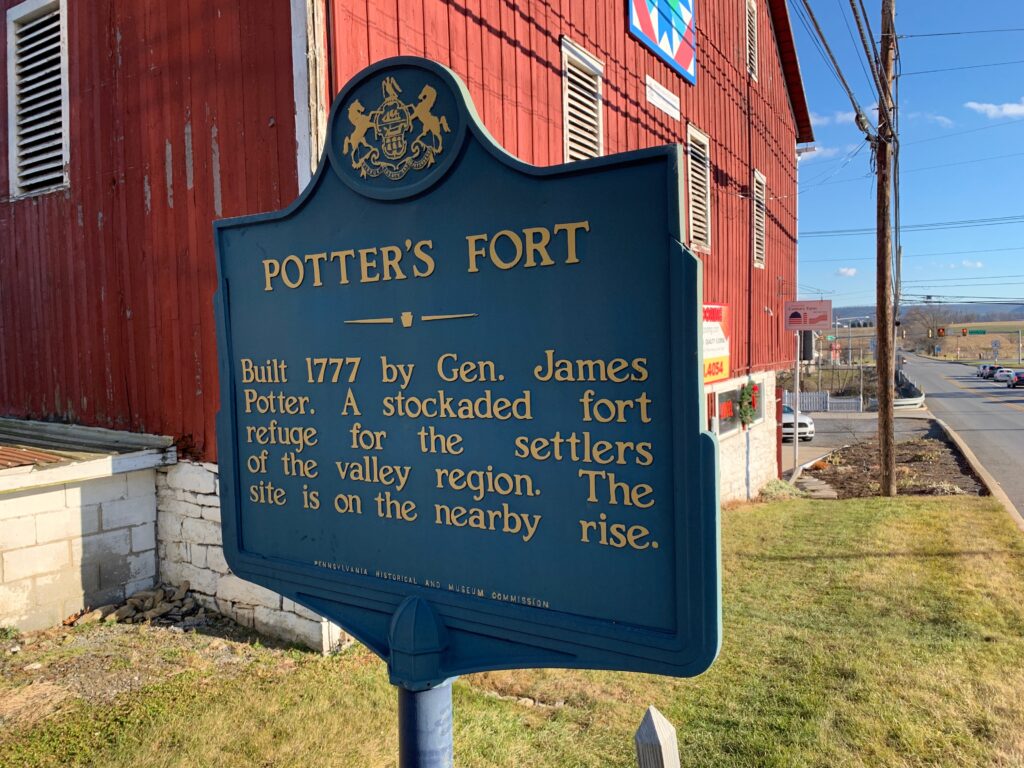General James Potter was a Pennsylvania military and political leader and frontier land developer, who is best known in Centre County for the exploratory trek that led him to the crest of Mount Nittany, overlooking Penns Valley, and his declaration that he had discovered an empire. In the 1770s, he was able to capitalize on his discovery, opening thousands of acres of Penns Valley to settlement, including what is today, Potter Township, named in his honor.
Potter was born in County Tyrone, Ireland in 1729, and came to America in the great Scots-Irish migration with his father, John Potter, when he was twelve. They settled near Greencastle, then in Cumberland County by 1746, and with the outbreak of the French & Indian War, James joined his father’s militia company as an ensign in 1756. He continued to serve through the war, rising to the rank of captain, and commanding troops through Pontiac’s Rebellion into 1764.
John Blair Linn’s History of Centre and Clinton Counties, the generally accepted source for the tale of Potter’s trek, suggested that while on the Kittanning expedition in 1756, he was taken with the idea of the potential wealth of land here. One of Linn’s sources says he took leave from the army in 1764 (although, based on land records, Linn asserts it could instead have been 1759). With a companion, traveled up the West Branch, then Bald Eagle Creek and Spring Creek, across the Nittany Valley to McBride’s Gap, and there from the ridge looking over the open plains, exclaimed, “By Heavens Thompson! I have discovered an empire!”
From a family source though comes a perhaps more poetic version. His great-granddaughter, Thomazine Potter Curtin (1883-1958), told the story that as Potter reached the top and looked out over the valley, he turned to his army servant and said, “Egad Wade, I’ve discovered an empire.” Not Thompson, the fellow army officer, but rather his young army servant Hero Wade, was the companion in this version.

Soon after the provincial land purchase of 1768 officially bought the northern half of today’s Centre County from the Iroquois, Potter moved to Sunbury and began developing farms across the Susquehanna, in what is today’s Union and Snyder counties. But Potter had also filed for claims in Penns Valley and led settlers there starting in 1773.
In less than two years, however, the American Revolution had begun. During the war, he led central Pennsylvania militia troops at the battles of Trenton, Princeton, Brandywine, and Germantown, and was promoted to the rank of brigadier general.
With the army encamped for the winter at Valley Forge, Potter was given leave to return to Penns Valley on account of his wife’s illness in January 1778. He remained here to deal with periodic Indian raids. At those times, the small number of families gathered for safety in the old fort he had constructed near present-day Centre Hall, but in the winter of 1778-79, the militia present joined the Sullivan Expedition, raiding the Iroquois towns in upstate New York, while the settlers fled south over the mountains to more protected areas.
Under the 1776 Constitution, the Commonwealth of Pennsylvania was governed by a Supreme Executive Council consisting of one elected representative from each county. In 1780, Potter was elected to a three-year term as Northumberland County’s representative to the council, and from November 1781 to November 1782, was the elected vice president of the Council, which made him the de facto lieutenant governor of Pennsylvania.
As his term neared its end, in May 1782, he was elected major-general of the Pennsylvania militia. His final office was to be elected, in 1784, to the Council of Censors. As another unique feature of the Commonwealth’s Constitution of 1776, the Council was elected every seven years to examine the actions of the state government, with the power to order impeachments and recommend the repeal of laws it deemed unconstitutional. It was the only body with the authority to call a convention to amend the constitution.
In the years until his death, he continued to develop his lands in Penns Valley. He was injured in the fall of 1789, while helping to raise a barn at a farm. He was taken to a doctor in Franklin County, where he died. At that time, Potter was one of Pennsylvania’s largest landowners.
Potter was married twice, first to Elizabeth Cathcart, and, after her death, to Mary Chambers. He was the father of five children.
A Pennsylvania historical marker near Centre Hall commemorates a Revolutionary era fort built by Potter. Its text reads “Potters Fort built 1777 by General James Potter. A stockaded fort refuge for the settlers of the valley region. The site is on the nearby rise.”
Thomazine Shanahan & Lee Stout
Sources:
Baum, Jane Curtin, compiler. The Roland Curtin Family of Centre County Pennsylvania. First edition, 2002.
Lee, J. Marvin. “Centre County: The Home of Governors,” Centre County Heritage. Vol. 15, No. 3 (Fall 1979).
Linn, John Blair. History of Centre and Clinton Counties. Philadelphia, 1883.
First Published: December 5, 2021
Last Modified: January 5, 2022
